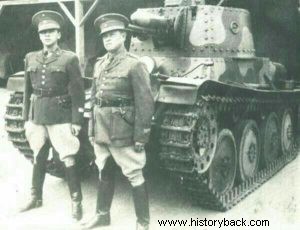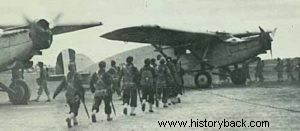
The War for the Zarumila Territory was the conclusion of a 111-year dispute between Peru and Ecuador over the possession of a zone of jungle... in the area of the Amazon tributary Zarumila.
Peru had regrouped its armed forces in the 1930s, even acquiring 24 Czechoslovak LTP-38 tanks , Italian Caproni Ca 135 and Ca 310 bombers, Ca 101 transports, Douglas 8A-3P close support and Ca -114 (biplane) and North American NA-50 (monoplane) fighters. The country's army numbered about 25,000 men. The artillery had 75 and 105 mm guns. Also dramatically improved the level of training of the army.
On the other hand the Ecuadorian army was in a tragic situation. It numbered only 7,500 men. It had only a few Italian reconnaissance aircraft and 65mm light guns. The paradox was that Ecuador was ruled, at that time, by a military government. Despite this and despite the high rhetoric he used he was completely unprepared for war.
The war
There had been several attempts to demarcate the disputed area, as early as the 19th century. In 1936 the two countries signed an agreement recognizing the existing borders. However, as early as 1938, conflicts broke out in the area. Who fired the first shot? To this day, the question remains unanswered.
However, on July 5, 1941, Peruvian forces invaded the Ecuadorian-controlled part of the region.
The Army Detachment “North” , under General Eloi Ureta, had the 1st and 8th Light Infantry Divisions (LIP), two cavalry regiments, a company of 12 tanks and a squadron of eight 150mm guns. and later a paratrooper division. Opposite Ecuador, he deployed only three battalions, one of them police.
According to the Peruvians, the guards of the Ecuadorian city of Huaquillas, located on the Zarumila River, breached the border and attacked a Peruvian patrol. Then 200 armed Ecuadorians attacked the city of Acqua Verde in Peru. The Peruvians reacted immediately and put the invaders to flight, counter-attacking and invading, under direct air cover, enemy territory the next day.
The Ecuadorian side, however, gives a different version, stating that Peruvian patrols and civilians were spotted on Ecuadorian territory. In any case the Peruvian forces crushed all resistance and invaded the province of El Oro , with the air force bombing the cities of Huaquilla, Areguilas, Santa Rosa and Macala.
At the same time, the Peruvians, pioneering, also used paratroopers, occupying from the air the important city-port of Puerto Bolivar. It was the first use of airborne forces in the Americas.
In the meantime the Ecuadorian army had been reinforced. But the dictator General Carlos de Rio, fearing his overthrow, kept 12,000 men under his command in the capital, ignoring the invasion. After the occupation of Macala, the dictator of Ecuador asked for a ceasefire. So operations were suspended on July 31, with Peru having by then thrown 13,000 of its men into battle and having occupied large areas of Ecuador.
The peace treaty signed in Rio, Brazil, with American mediation, gave Peru an area of 80,000 square miles. After this the Peruvian forces withdrew. However, Ecuador backed down. The final peace treaty was only signed in October 1998!
Casualties on either side were not that significant from enemy action. Ecuador had 148 dead and 235 injured, compared to 84 and 72, respectively, for Peru . However, the losses from the jungle and diseases were overwhelmingly multiple. Many civilians also perished mainly due to diseases and hardships.

Douglas 8A-3P aircraft of Peru.

Ca -114 aircraft of Peru.

North American NA-50 fighter of Peru.

Peruvian officers in front of LTP-38 tank.

Peruvian paratroopers.
